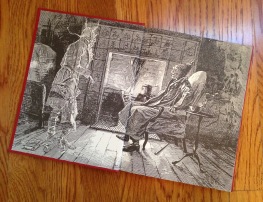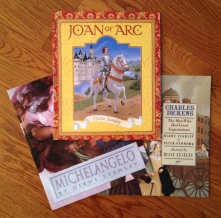The Good Book – Last week my son and I read through Graphic Library’s “Johann Gutenberg and the Printing Press”. Excellent! Just enough information about Bibles and print reproduction methods of the 1400s. My son was engaged with every single comic-book-style page, so I am looking at other topics covered by Graphic Library.
New information for us:
– we learned that before 1455 (pre-Gutenberg’s printing press), monks who worked on Bibles had to use sunlight to illuminate their work stations; candles were not used in the manuscript shop because of the fire threat
– we learned that the path from the idea of movable type to the actual printing of a Bible was a LONG path: more than 25 years of continual work – the letters, the ink, the press, the relentless search for financial backing
– we learned that Gutenberg stored his metal letters in cases. The capital letters in the “UPPER CASE” and the smaller letters in the “LOWER CASE”. Thus, the terms!
– 200 Gutenberg Bibles were printed and 48 remain (we talked about the current $$$ value, oh my gosh)
Also studying – “Popular Patents – America’s first Inventions from the Airplane to the Zipper” by Travis Brown. This book is so well researched and so interesting, including patent number details (we sort of skip all of that), and chronological order of “what came before what” in regards to each patented invention. So far we have read about barbed wire and the bottle cap, and we are coming to realize that: 1) the type of person that invents, does so over and over and over – the inventors we’ve read about hold MANY patents, and 2), as we learned this from our study of Thomas Edison, successful inventors protect their ideas with a patent. Poor Gutenberg, how he could have used patent protection.
Story Problems for Sun Days – It is so hot this summer at Farmer Brown’s:
Farmer Brown’s cool farm hands: Farmer Brown knows that a cool farm hand is a productive farm hand, so he is installing 6 new fans in the farm hands’ bunkhouse. He is planning to purchase 4 traditional type large fans for $48 each and 2 state-of-the-art Dyson pedestal fans for $450 each. Farmer Brown’s accountant says this is certainly a business expense and needs to know the total spent. Without calculating on paper or with calculator, what is most likely the total of the 6 fans?
A: $4,800 B: $948 C: $1,092 D: $2,000 (answer at bottom of post)
Farmer Brown’s corn maze: Farmer Brown decided to join the corn maze craze. His angle: the state’s smallest maze (for those that freak out at the thought of becoming lost amid the acreage of a typical corn maze)! Farmer Brown’s maze is going to be 15 feet by 15 feet. At the end of the maze, Farmer Brown will serve up complimentary corn on the cob. The attraction will be open July and August. If an entrance fee of $3 is charged, and on an average 200 people go through the maze each month, and Farmer Brown spends 50 cents for each ear of corn/butter/salt and pepper, how much money will Farmer Brown net by the end of August? (answer at bottom of post)
Music for a Sunday night – Sunday nights are church-type music nights for us, so what better than the sound of a harp to put us in mind of angels? The three ultra-soothing pieces we listened to last Sunday night were all composed in the 1700s.
First, George Frederick Handel’s “Harp Concerto in B flat Major”, movement 1, written in 1736. This movement is beautifully presented by an orchestra in Istanbul, Turkey (sorry, I couldn’t decipher any more information, it was effort enough to figure out the city) (harpists’ ruffled dresses = adorable):
Second, “Harp Concerto in A Major”, movement 3, composed in the late 1700s (best we could do in terms of a date) by (here comes awesome name of the month): Carl Ditters von Dittersdorf. Such a FUN name to say. Every single time. This particular video features a VERY young and most talented harpist:
Finally, Mozart’s “Concerto for Flute and Harp”, movement 2, composed in 1778. This is such a gorgeous yearning melody, presented by a most accomplished student orchestra in Russia and featuring another very young harpist:
Welcome to the best part of my day!
Jane BH
(story problem answer – Farmer Brown’s cool farm hands – C: $1,092)
(story problem answer – Farmer Brown’s corn maze – $1,000)































